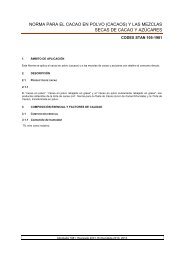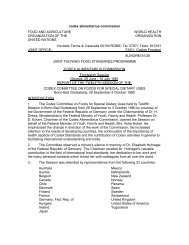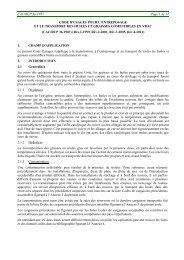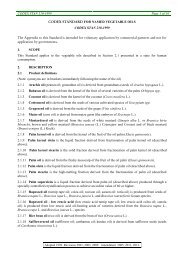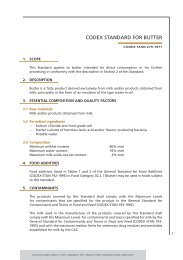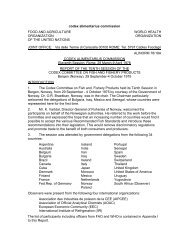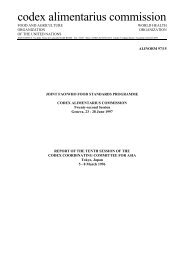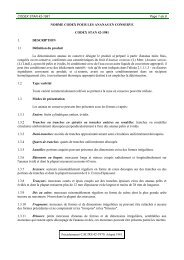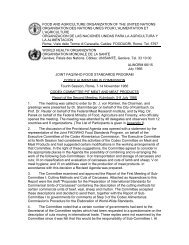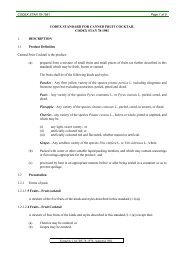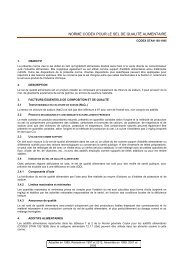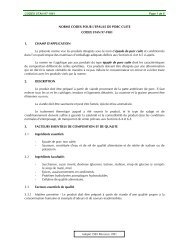REP13/FH JOINT FAO/WHO FOOD STANDARDS PROGRAMME ...
REP13/FH JOINT FAO/WHO FOOD STANDARDS PROGRAMME ...
REP13/FH JOINT FAO/WHO FOOD STANDARDS PROGRAMME ...
You also want an ePaper? Increase the reach of your titles
YUMPU automatically turns print PDFs into web optimized ePapers that Google loves.
<strong>REP13</strong>/<strong>FH</strong> Appendix IV 53<br />
Reassessment of the potential for microbial contamination is necessary when events or other conditions<br />
indicate that water quality may have changed.<br />
3.2.1.2 Manure, biosolids and other natural fertilizers<br />
The use of untreated manure and liquid manure should be avoided to the extent possible. Foodborne<br />
pathogens can persist in soil for long periods of time and as some berries have a short production cycle, they<br />
could become contaminated by pathogens in the manure.<br />
Growers who are purchasing manure, biosolids and other natural fertilizers that have been treated to reduce<br />
microbial or chemical contaminants should obtain documentation from the supplier that identifies the origin,<br />
treatment used, tests performed and the results thereof. Growers may also evaluate the need to verify the<br />
information provided by the supplier on testing for contamination of natural fertilizer samples or auditing the<br />
composting process.<br />
3.2.3 Personnel health, hygiene and sanitary facilities<br />
Personal hygiene is critical with manual harvesting due to the amount of human handling that could lead to<br />
contamination of berries. Whenever possible, harvesting, packing and inspection processes should be<br />
designed to reduce fruit handling. All agricultural workers should properly wash their hands using soap and<br />
clean running water and dry their hands before handling berries, particularly during harvesting and postharvest<br />
handling.<br />
If gloves are used, a procedure for glove use in the field should be documented and followed. If the gloves<br />
are reusable, they should be made of materials that are easily cleaned and disinfected, and they should be<br />
cleaned regularly and stored in a clean area. If disposable gloves are used, they should be discarded when<br />
they become torn, soiled, or otherwise contaminated. Glove use alone is not a suitable substitute for good<br />
hand washing practices.<br />
Where appropriate, each business operating primary production should have written Standard Operating<br />
Procedures (SOPs) that relate to health, hygiene and sanitary facilities. The SOPs should address worker<br />
training, facilities and supplies to enable agricultural workers to practice proper hygiene, and company<br />
policies relating to expectations for worker hygiene as well as illness reporting.<br />
Non-essential persons, casual visitors and, to the extent possible, children, should not be allowed in the<br />
harvest area as they may present an increased risk of contamination.<br />
3.2.3.1 Personnel hygiene and sanitary facilities<br />
Growers should consider providing areas away from the field and packing lines for agricultural workers to<br />
take breaks and eat. For worker convenience, these areas should provide access to toilet and hand-washing<br />
facilities so that agricultural workers can practice proper hygiene.<br />
As far as possible, sanitary facilities should be located close to the field and readily accessible to the work<br />
area.<br />
Sanitary facilities should be located in a manner to encourage their use and reduce the likelihood that<br />
agricultural workers will relieve themselves in the field. Facilities should be present in sufficient<br />
number to accommodate all personnel.<br />
Portable facilities should not be located or cleaned in cultivation areas or near irrigation water sources<br />
or conveyance systems. Growers should identify the areas where it is safe to put portable facilities.<br />
Facilities should include clean running water, soap, toilet paper or equivalent, and single use paper<br />
towels or equivalent. Multiple use cloth drying towels should not be used. Hand sanitizers should not<br />
replace hand washing and should be used only after hands have been washed.<br />
If clean running water is not available, an acceptable alternative hand washing method should be<br />
recommended by the relevant competent authority.<br />
3.2.3.2 Health Status<br />
The following should be considered:<br />
Growers should be encouraged to recognise symptoms of diarrhoeal or food-transmissible<br />
communicable diseases, and reassign agricultural workers as appropriate.<br />
Agricultural workers should be encouraged and, where feasible, be motivated with appropriate<br />
incentives to report symptoms of diarrhoeal or food-transmissible communicable diseases.



